Winged Cupid and Psyche ... More Canova
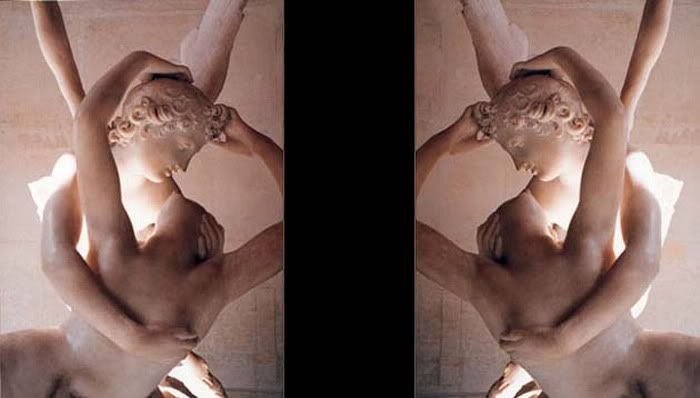
I'm not done with Canova yet.
The reason I was familiar with the artist, when Pearl sent me that image was because I already had fallen in love with one of his sculptures, another version of the Cupid and Psyche myth that he had done.
The piece I swooned over is extremely daring, technically, as works in stone go. It is not small, yet it is all over the place in terms of limbs and wings extending this way and that. I don't know much about how stone is worked by artists, but I can't help but think that this sort of piece is assembled, somehow -- put together -- not carved whole out of one huge block.
Edited to add: I found a site that gave the overall dimensions of the piece. It is not large. I suppose it seemed large to me because it is in the foreground, making the museum visitors look smaller (an old Pete Jackson trick!). The figures are not even hobbit-sized, for the dimensions are: H 0.55 m; W 0.68 m; D 1.01 m
Once again, to demonstrate Canova's ability to express both the erotic and the tender in one piece, here is a close-up of the faces.
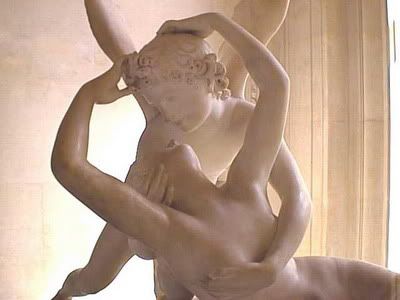
Cupid and Psyche by Antonio Canova, c. 1796.
The story of Cupid and Psyche is perhaps my favourite of all myths, the story of Divine Love descending to earth, having fallen in love with a beautiful mortal. That love is tested; the mortal lover fails to fully trust her immortal lover, and Divine Love is lost to her. But, after many trials, the mortal lover is forgiven and is raised by her lover to heaven, to join him in his immortality.
Some people interpret this as the union of bodily, erotic love (Eros - Cupid) and the love of the soul (Psyche meaning soul). No wonder its appeal is so powerful. Surely the joining of body and soul in love is the nearest mythical approximation to the sort of love many fans feel for Frodo. It should not be surprising, then, that so many fanfics seem to resonate with this myth. All profound love stories do (in my opinion, of course).
In most Frodo fanfics, mortal, of-the-earth Sam gets cast as Psyche ("How could he love me? I don't deserve it!" etc.) and Frodo is the divine hobbit dropped out of the firmament of Arda into the West Farthing of the Shire, to raise Sam up with him to the heights of Love Eternal. The myth echoes through my own love story. It is inevitable that it be so. But I have tried to make my protagonists clearly and solidly mortal. Still, they participate in the "dance" or "ritual" of the myth, as all real-life lovers of any depth do, entering through the love that mortals are able to experience into the mysteries of a love that transcends anything they can know or imagine.
In the piece, Cupid (having softened from hearing of Psyche's travails on earth on his behalf) is depicted as having just descended to his lover. He finds her in a swoon from her ordeals (which were quite rigorous in the myth). He professes his undying love. Afterwards, holding her in his embrace, he transports her with him to heaven. Obviously, this myth has clear orgasmic imagery, but it is meant to signify much more. Which is what makes it powerful and memorable as myth.
Edited to add:
I checked the myth in a translation from Bulfinch (who was working from Apuleius), and I think I could be wrong about which part of the story Canova's marble group portrays. I had thought it depicted Cupid returning for the distraught Psyche. But I noticed one image of the statue posted at an art history website that referred to it as depicting Cupid departing from Psyche.
In that case, I think it would have been meant to show the following scene, in which Cupid is leaving Psyche, not returning for her.
Oh, *SOB* for the beauty and angst of it, if that is so. Here is the passage from Bulfinch:
Psyche resisted these persuasions as well as she could, but they did not fail to have their effect on her mind, and when her sisters were gone, their words and her own curiosity were too strong for her to resist. So she prepared her lamp and a sharp knife, and hid them out of sight of her husband. When he had fallen into his first sleep, she silently rose and uncovering her lamp beheld not a hideous monster, but the most beautiful and charming of the gods, with his golden ringlets wandering over his snowy neck and crimson cheek, with two dewy wings on his shoulders, whiter than snow, and with shining feathers like the tender blossoms of spring. As she leaned the lamp over to have a nearer view of his face a drop of burning oil fell on the shoulder of the god, startled with which he opened his eyes and fixed them full upon her; then, without saying one word, he spread his white wings and flew out of the window. Psyche, in vain endeavouring to follow him, fell from the window to the ground. Cupid, beholding her as she lay in the dust, stopped his flight for an instant and said, "O foolish Psyche, is it thus you repay my love? After having disobeyed my mother's commands and made you my wife, will you think me a monster and cut off my head? But go; return to your sisters, whose advice you seem to think preferable to mine. I inflict no other punishment on you than to leave you for ever. Love cannot dwell with suspicion." So saying, he fled away, leaving poor Psyche prostrate on the ground, filling the place with mournful lamentations.
Link to full text: http://ancienthistory.about.com/library/bl/bl_text_bullfinch_11.htm
* * *
Here are more views of this sublime piece of Neo-classical art ....
Front view:
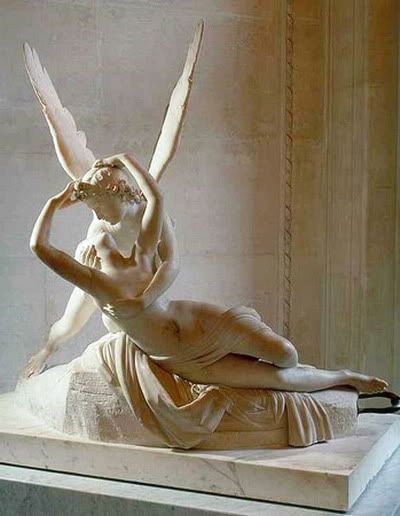
Here is the side view. Not only is it gorgeous because of its beautiful subject, it is an amazing piece of craftsmanship. This is stone, not plastic. Look at the extension of his leg and wings. It is astounding.
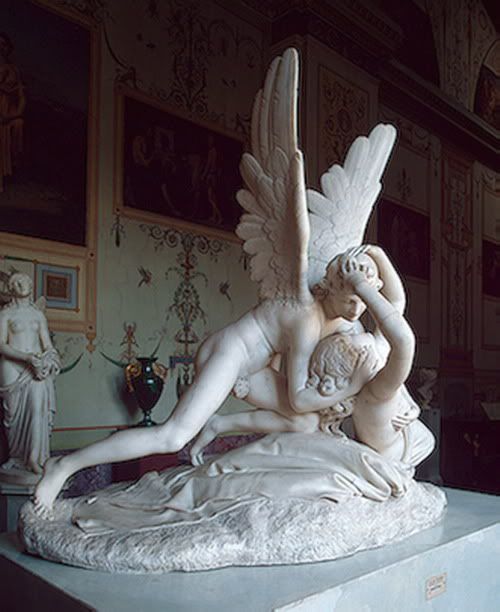
Here's a rear view for the "bum" lover in us all. Ah, so lovely!
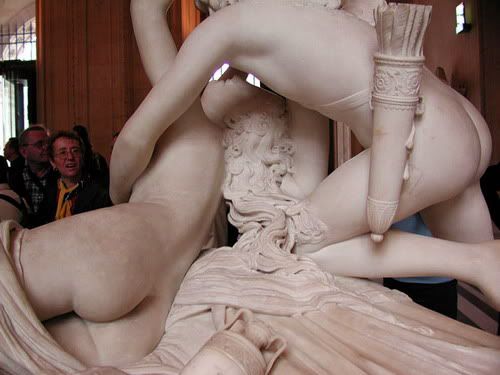
When I saw the following image of this statue, I nearly fainted, so ecstatic was I at the sight of it. The photographer must have lit it -- or caught it so lit -- bathed in glowing, buttery-golden light as if from morning sun.
I think it is inexpressibly beautiful.
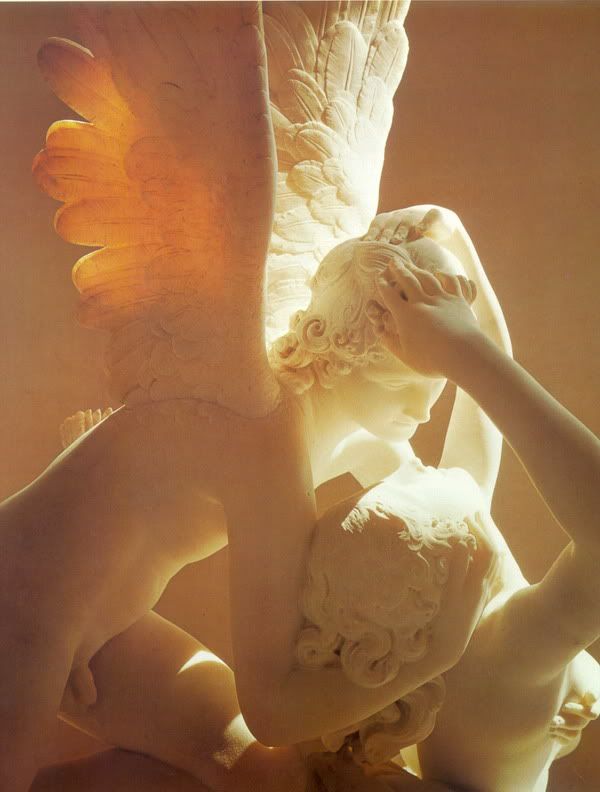
Now, last but not at all least, for my "Frodo and Rosamunda" fans, I must present the piece of sculpture that inspired me to find the Canova piece in the first place. I was looking for a depiction in art of Cupid and Psyche last summer, having come to see some parallels between it and certain erotic love passages in my text. Googling up the names in Images, I happened across a sculpture I had never seen before.
Yet another interpretation of the Cupid and Psyche story, Auguste Rodin's far more modern piece (more than a hundred years after Canova's) is a different sort of statue altogether, but equally beautiful, I think. In this statue, the viewer has left the immortals behind. I find myself looking (open-mouthed) at a pair of lovers, plain and simple.
Rodin could call it whatever he wanted, but, to my mind, it is merely the most gorgeous, most ravishing depiction of real, human erotic love I have ever seen. I thought when I saw it, "Now this depicts the love scenes in my story!"
Cupid and Psyche by August Rodin, c. 1905-1908:
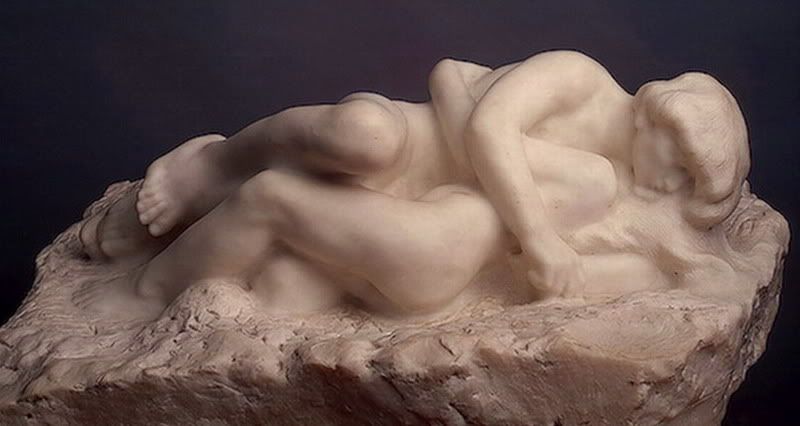
~ Mechtild